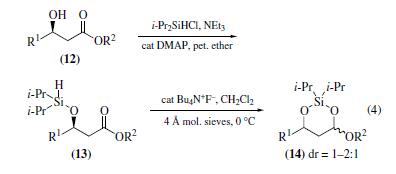|
| | DIISOPROPYLCHLOROSILANE Basic information |
| | DIISOPROPYLCHLOROSILANE Chemical Properties |
| Boiling point | 58-60 °C50 mm Hg(lit.) | | density | 0.883 g/mL at 25 °C(lit.) | | refractive index | n20/D 1.429(lit.) | | Fp | 72 °F | | storage temp. | Inert atmosphere,Room Temperature | | solubility | generally sol organic solvents; reacts with alcohols,
ammonia,and water. | | form | clear liquid | | color | Colorless to Almost colorless | | Specific Gravity | 0.883 | | Hydrolytic Sensitivity | 8: reacts rapidly with moisture, water, protic solvents | | BRN | 2231355 | | CAS DataBase Reference | 2227-29-4(CAS DataBase Reference) | | EPA Substance Registry System | Silane, chlorobis(1-methylethyl)- (2227-29-4) |
| Hazard Codes | C | | Risk Statements | 10-34 | | Safety Statements | 26-36/37/39-45 | | RIDADR | UN 2986 8/PG 2 | | WGK Germany | 3 | | F | 10-21 | | TSCA | Yes | | HazardClass | 3.1 | | PackingGroup | II | | HS Code | 29319090 |
| | DIISOPROPYLCHLOROSILANE Usage And Synthesis |
| Physical properties | bp 150–153°C,bp 54–55°C/45 mmHg;
d 0.872 gmL?1 | | Uses | Intramolecular
hydrosilylation is also possible within β-diisopropylsilyloxy
esters (13), constituting an exceptionally mild method for reducing
ester groups to the aldehyde oxidation level (eq 4).The derivatives
(13) may be synthesized from β-hydroxy esters (12) as described
above for the analogous ketones. Treatment with fluoride
ions (but not Lewis acids) induces hydride transfer to give
alkoxysiladioxanes (14) in excellent yields (≥95%). Although
usually performed in dichloromethane, the hydrosilylation may
also be accomplished with ethyl acetate as solvent, providing
strong evidence for intramolecularity. | | Application | Used in a silylation-reduction-allylation sequence of
β-hydroxy esters to homoallylic-substituted 1,3-diols.
Used in the silylation-hydrosilation-oxidation of allyl
alcohols to 1,3-diols. Reaction carried out in
diastereoselective manner. Reduces β-hydroxy ketones to
anti-1,3 diols. | | Preparation | obtained by reaction of trichlorosilane with
isopropylmagnesium chloride;the original yield of 45% may
be raised to 70–80% by employing conc hydrochloric acid to
quench the reaction. | | Purification Methods | Impurities can be readily detected by 1H NMR. Purify it by fractional distillation [Gilman & Clark J Am Chem Soc 69 1499 1947, Allen et al. J Chem Soc 3668 1957]. |
| | DIISOPROPYLCHLOROSILANE Preparation Products And Raw materials |
|



